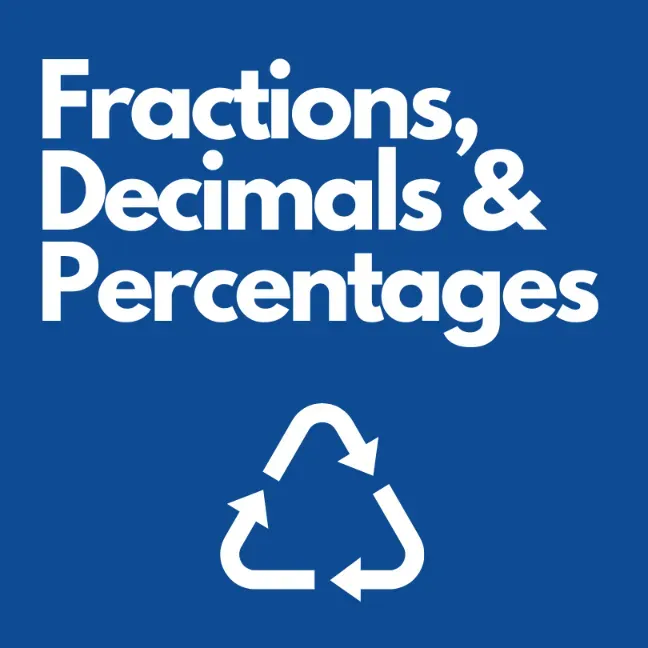Fraction to Percent Calculator
Enter a fraction using positive or negative numbers
Related Fraction, Decimal & Percent Calculators
See all maths calculators
Fraction to Percent Conversion Guide
The Fraction to Percent Converter is a powerful tool that allows you to transform fractions into their equivalent percentage representations. This comprehensive guide will walk you through the process of using such a converter, explain the concepts behind fraction-to-percent conversion, provide practical examples, and offer insights into common pitfalls and real-world applications.
Understanding Fractions and Percentages
Before diving into the conversion process, let's clarify some key concepts:
Fractions
A fraction represents a part of a whole. It consists of a numerator (top number) and a denominator (bottom number). For example, in the fraction 3/4, 3 is the numerator and 4 is the denominator.
Percentages
A percentage is a way of expressing a number as a part of 100. It is denoted by the symbol %. For example, 75% means 75 out of 100, or three-quarters of a whole.
Converting Fractions to Percentages
The process of converting a fraction to a percentage involves three main steps:
- Divide the numerator by the denominator.
- Multiply the result by 100.
- Add the % symbol.
For example, to convert 3/4 to a percentage:
- 3 ÷ 4 = 0.75
- 0.75 × 100 = 75
- 75%
Therefore, 3/4 = 75%
Examples of Fraction to Percent Conversions
Let's look at a table of examples:
| Fraction | Conversion Process | Percentage Result |
|---|---|---|
| 1/2 | (1 ÷ 2) × 100 | 50% |
| 1/4 | (1 ÷ 4) × 100 | 25% |
| 3/4 | (3 ÷ 4) × 100 | 75% |
| 1/3 | (1 ÷ 3) × 100 | 33.33% (approx.) |
| 2/5 | (2 ÷ 5) × 100 | 40% |
| 5/4 | (5 ÷ 4) × 100 | 125% |
| 1/8 | (1 ÷ 8) × 100 | 12.5% |
| 7/10 | (7 ÷ 10) × 100 | 70% |
Common Mistakes to Avoid
When using a Fraction to Percent Converter, be aware of these common pitfalls:
-
Inverting the fraction: Make sure you're dividing the numerator by the denominator, not the other way around.
-
Forgetting to multiply by 100: Remember, percentages are out of 100, so you need to multiply your decimal result by 100.
-
Rounding errors: Be cautious with fractions that don't convert to exact percentages (like 1/3).
-
Mishandling improper fractions: Remember that improper fractions (where the numerator is larger than the denominator) will result in percentages over 100%.
-
Omitting the % symbol: Don't forget to include the % symbol in your final answer.
Practical Applications
Understanding how to convert fractions to percentages has numerous real-world applications:
Academic Grading
Test scores are often given as fractions and converted to percentages.
Example: If a student scores 18/20 on a test, this converts to 90%, typically an A grade.
Finance and Investing
Many financial concepts involve converting fractions to percentages.
Example: If a stock price increases from $80 to $100, the fractional increase of 20/80 converts to a 25% increase.
Statistics and Data Analysis
Fractions often need to be converted to percentages for clear data representation.
Example: If 3/5 of survey respondents prefer product A, this can be reported as 60% preference for product A.
Cooking and Nutrition
Nutritional information and recipe scaling often involve fraction to percentage conversions.
Example: If 1/4 of a food's calories come from fat, this can be expressed as 25% of calories from fat.
Real World Analogies (RWA)
To better understand fraction to percent conversions, consider these real-world analogies:
-
Pizza Slices:
- If you eat 1/4 of a pizza, you've consumed 25% of the pizza.
- If 3/8 of a pizza remains, 37.5% of the pizza is left.
-
Time Management:
- If you spend 1/3 of your day sleeping, that's approximately 33.33% of your day.
- If you work for 3/8 of the day, that's 37.5% of your day spent working.
-
Sports Statistics:
- If a basketball player makes 7/10 free throws, their free throw percentage is 70%.
- If a baseball team wins 3/5 of their games, they have a 60% win rate.
-
Sales and Discounts:
- If an item is discounted by 1/5 of its original price, it's on sale for 20% off.
- If you've saved 3/8 of the money needed for a purchase, you're 37.5% of the way to your goal.
These real-world analogies help to ground abstract fraction-to-percent conversions in concrete, everyday situations, making them easier to understand and remember.
Using Technology: Fraction to Percent Converters
While it's important to understand the manual process, Fraction to Percent Converters can quickly perform conversions, especially for complex fractions. When using such converters:
- Verify the input format required by the converter (e.g., whether to use "/" or ":" for fractions).
- Double-check your entries for accuracy.
- Understand the output format provided by the converter (number of decimal places in the percentage).
- Use the results judiciously, especially in professional or academic contexts where showing your work may be required.
The Importance of Understanding Fraction to Percent Conversions
Converting fractions to percentages is a fundamental skill that extends beyond simple arithmetic. It's crucial for many fields including academics, finance, statistics, and everyday calculations. By mastering these conversions, you enhance your numerical literacy and problem-solving skills.
Conclusion
Using a Fraction to Percent Converter to transform fractions into their percentage equivalents is a valuable skill that enhances your ability to work with numerical data. Whether you're a student, a professional, or simply someone who enjoys working with numbers, understanding this process can improve your mathematical capabilities and practical problem-solving skills.
Remember, while converters are powerful tools, understanding the underlying concepts is crucial. Practice manual conversions alongside using the converter to develop a deep understanding of the relationship between fractions and percentages.
Key Takeaways
- Understand that a fraction represents a part of a whole, while a percentage represents a part of 100.
- To convert a fraction to a percentage, divide the numerator by the denominator, multiply by 100, and add the % symbol.
- Be aware of common mistakes such as inverting the fraction or forgetting to multiply by 100.
- Recognize the practical applications in academics, finance, statistics, and cooking.
- Use real-world analogies to better understand and remember fraction-to-percent conversions.
- While converters are helpful, understanding the manual process is crucial for developing mathematical intuition.
- Remember that some fractions (like 1/3) convert to approximate percentages, while others (like 1/4) convert to exact percentages.
By mastering fraction to percent conversions, you'll have a powerful tool at your disposal for understanding and working with numerical data in various real-world scenarios.

